I'm sitting here on a Sunday morning, drinking a cup of coffee I made at home with bottled water. Why bottled water? Because of a massive water main burst west of Boston – Boston and 30+ other communities currently have unsafe drinking water and a boil order in effect. Cambridge, across the river, has a different water source so they are OK and we'll be able to drink the water at the LEI office on Monday.
This water emergency is leading to new “standardized work” at home, restaurants, Starbucks, and local hospitals. This requires new habits – how do we communicate them and put the new methods in place? How do we communicate effectively? How do we remind ourselves to NOT drink the tap water? Will “just in time” be blamed? Here's my post…
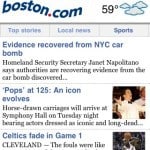 I caught wind of the problem via a Facebook friend's post. Ah, the new way to learn about news. I then checked Twitter and found an official announcement from the City of Boston. Amazingly (and this was true through 10 PM) the mobile site for Boston.com (run by the Boston Globe) had NOTHING about the water emergency (but they had the updated Red Sox score). They don't even have this water emergency featured on the main mobile.Boston.com page today at 10:20 am (see screen grab on right). Shame on you, Boston Globe (although it is the huge headline in the print edition of the Sunday paper).
I caught wind of the problem via a Facebook friend's post. Ah, the new way to learn about news. I then checked Twitter and found an official announcement from the City of Boston. Amazingly (and this was true through 10 PM) the mobile site for Boston.com (run by the Boston Globe) had NOTHING about the water emergency (but they had the updated Red Sox score). They don't even have this water emergency featured on the main mobile.Boston.com page today at 10:20 am (see screen grab on right). Shame on you, Boston Globe (although it is the huge headline in the print edition of the Sunday paper).
So there's a communication challenge — you have to get word out to as many people as possible. After 7 PM, the local CBS affiliate was running a news scroll across the bottom of the screen, but not the Fox affiliate. An effective way to communicate this emergency would have been NESN, as many Bostonians were watching the Red Sox game — but no announcement there.
Any change management initiative requires effective communication and it seems like a less than coordinated response. Boston police cruisers were driving the streets making announcements over bullhorns. But, even today, there aren't signs posted on street corners.
Some communication is taking place via the two Starbucks on our street, with signs in the window (different at each location) explaining the situation (sort of):
And
Yet, people were walking the street with Dunkin Donuts hot beverage cups. So, somebody's making coffee, it seems — bottled water? Correction: The Dunkin coffee probably came across the bridge from Cambridge, where the water was OK.
The sign was later updated (probably based on customers repeatedly asking the same questions over and over). I guess the baristas taking action to update the sign is an example of kaizen. They didn't need a central top-down order from Seattle headquarters to make this happen.
One thing missing from all of this, even the Boston Globe and the city announcements was any information about WHY it is unsafe to drink the water. Would it kill you? Make you mildly sick?
The MWRA website and its announcements say nothing very specific:
Boil water orders are preventative measures issued to protect public health from waterborne infectious agents that could be or are known to be present in drinking water.
What infectious agents? To what effect?
If you dig a bit, you find this Boston Globe article (“Residents, businesses race to adapt; water vanishes from stores“), and it says:
All water to be ingested, including water used for cooking and making baby formula, should be boiled for at least a minute to kill potentially harmful bacteria such as E.coli and giardia, Convery said.
So now we know WHAT is in the water. It's harmful, but how harmful? This different Globe article says:
Q. What are the risks if I drink the tap water?
A. For most people, minor gastrointestinal illness. The biggest concerns are for those with compromised immune systems, such as people with HIV or who are undergoing chemotherapy.
Emergency water reaching many taps was being channeled from open-air reservoirs such as Chestnut Hill and Spot Pond in Stoneham, watering holes possibly contaminated by goose and deer droppings.
Why isn't all of that information in one consolidated place?
Why aren't news sources and authorities doing a better job of explaining WHY? Just being authoritarian and saying “don't drink the water!” isn't as a effective as more specific communication that explains the impact of not following the order. I wrote about a similar theme a few years ago after I toured the NUMMI plant (“NUMMI Tour Tale #3: The Power of Why“).
So, my challenge is to explain “why” as much as possible. Not just asking why, but explaining why. I hope you can take that challenge on for yourself. Why are we doing lean? Why is it necessary to standardize our workbenches? Why is it important to get these parts off MRP and onto a kanban system? I bet we would all do better by taking the time to explain why.
Some of the new standardized work involves hospitals that have dirty water. Doctors are being told to scrub in for surgery with bottled water, because of the bacterial risk. Let's hope that new temporary standardized work is communicated effectively (with some “why” statements) and that it's being followed.
Here at home, I'm trying to help error proof this. We're not supposed to brush our teeth with the tap water, so I set a gallon of water on the sink the bathroom as a visual reminder. I guess I could post a bunch of warning signs. I'm trying to make it easy to do the right thing.
We managed to buy some water. Even this morning, the CVS store near us had bottles of water (not gallon sizes). Bottles of drinking water were even still on sale (thanks for not price gouging!).
As the news stories show pictures of empty shelves, I'm just waiting for the articles criticizing “just in time” inventory practices.This is clearly an unusual situation where demand for bottled water is not normally this high. You can't plan inventory for all eventualities. Heck, the stores in Boston don't have enough room to store that much inventory anyway.
All we can hope for is more frequent deliveries at this point and I assume the retailers will be able to respond quickly.
What do you think? Please scroll down (or click) to post a comment. Or please share the post with your thoughts on LinkedIn – and follow me or connect with me there.
Did you like this post? Make sure you don't miss a post or podcast — Subscribe to get notified about posts via email daily or weekly.
Check out my latest book, The Mistakes That Make Us: Cultivating a Culture of Learning and Innovation:



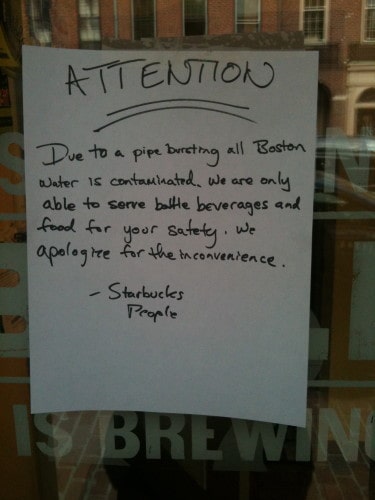
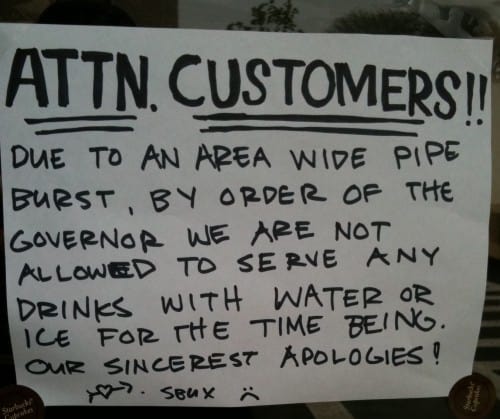
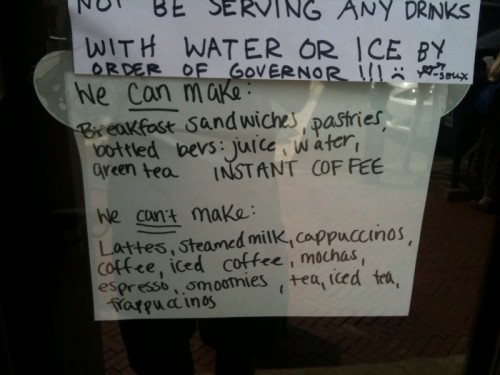
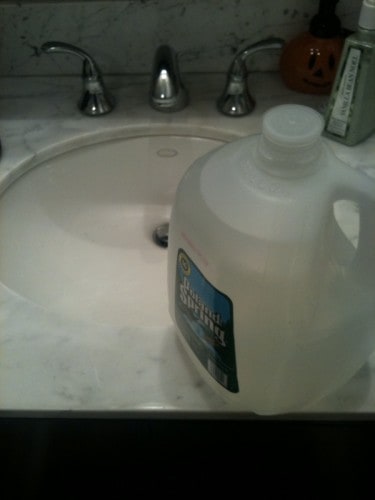







I heard a rumour that Boston leaders were thinking of asking Toyota to recall the pipe that burst!
Joking aside though, I’m enjoying reading your blog. You have an interesting way of getting across “lean” points.
Regards
Ian
At least the local NBC station has a continuous scroll during the NHL hockey game that’s on today…
Mark,
I have a sign on my bathroom sink.
That’s why you have the blog and I read the blog.
My wife points out that the water bottle is just outside the room, but it’s not easier to use it than not to use it.
-Andy
Andy – so you’re not on the Cambridge water supply then. Bummer. Did you put the sign up because of the blog or your own obsessive thinking that parallels mine? :-)
I might try brushing my teeth with beer, ha ha.
Andy, here’s an illustration of human error (or a near miss) under unusual or stressful conditions:
http://www.boston.com/news/local/massachusetts/articles/2010/05/03/under_the_water_emergency_daily_life_adapts_to_the_new_normal/
Hi Mark,
Michael Ballé tells us to agree on the main problem before thinking of a solution. So what is the main problem here?
Security? Do we have a risk of being injured or worse? why?
Quality? of water? of the information received?
Delivery? It seems you’re not out of water?..but out of information!
Cost? It seems you have to boil water to drink it, which may be cheaper than putting “muri” on the supply chain by buying mineral water nobody’s asked you.
So what’s the problem for Boston’s people?
I too found out through Facebook. Cute, way to go, Boston! Why is it that Quincy, Nahant et al were not only able to get the word out but get bottled water out to the citizens through the National Guard? Having someone yell “boil water” (or “bawwwadda”) doesn’t ease panic, it creates it.
I called the mayor’s hotline and was told that there was NO bottled water in the city at all. I’ve had to boil the water owing to not getting the information in a timely manner, and I’m paying for it now. Absolutely fumbled on the city’s part. Not happy at all with how this was communicated and handled.
Hi there, I have acne on my face.
And I was wondering if washing my face with tap water + my daily face wash would affect my skin in any way. (ie. irritate it, cause redness, make it worse).
I had already washed it a few times, so I’m getting paranoid.
Anyone know the answer?
Did you explore if a the water can be filtered?
If so, I wonder what the cost of that filter would be?
In TW drinking water is usually bottled, or filtered with teh filtered water costing about .15 USD per gallon.
They say the water is safe now:
http://www.boston.com/news/local/breaking_news/2010/05/gov_patrick_lif.html
Here’s the standardized work for restoring clean water to your sink, dishwasher, etc.:
http://www.boston.com/news/local/breaking_news/2010/05/guidelines_for.html
Anna, would you have gotten any information from the “211” line that was set up?
[…] This method worked for me during a similar water problem in Boston back in 2010. […]